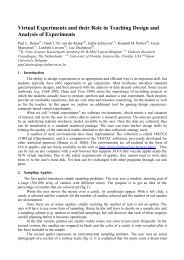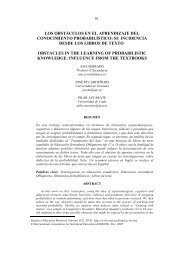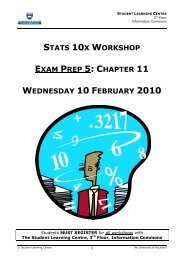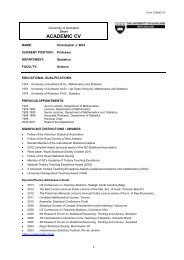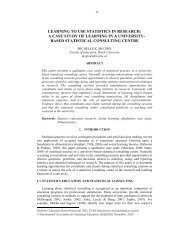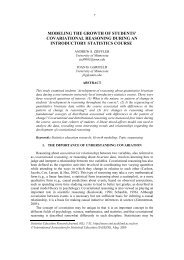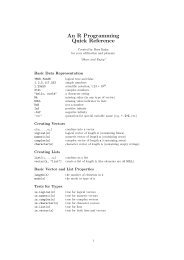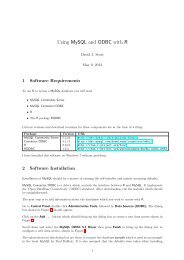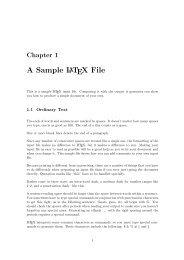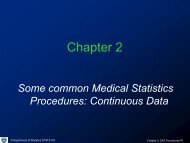The beamer class
The beamer class
The beamer class
You also want an ePaper? Increase the reach of your titles
YUMPU automatically turns print PDFs into web optimized ePapers that Google loves.
typeset in the largest font, but you your attention will nevertheless first go to the topics advertised on the<br />
cover. Likewise, in the table of contents you are likely to first focus on the entries, not on the words “Table<br />
of Contents.” Most likely, you would not spot a spelling mistake there (a friend of mine actually managed to<br />
misspell his own name on the cover of his master’s thesis and nobody noticed until a year later). In essence,<br />
large text at the top of a page signals “unimportant since I know what to expect.” So, instead of using a<br />
very large frame title, also consider using a normal size frame title that is typeset in bold or in italics.<br />
5.6.2 Font Families<br />
<strong>The</strong> other central property of any font is its family. Examples of font families are Times or Helvetica or<br />
Futura. As the name suggests, a lot of different fonts can belong to the same family. For example, Times<br />
comes in different sizes, there is a bold version of Times, an italics version, and so on. To confuse matters,<br />
font families like Times are often just called the “font Times.”<br />
<strong>The</strong> are two large <strong>class</strong>es of font families: serif fonts and sans-serif fonts. A sans-serif font is a font in<br />
which the letters do not have serifs (from French sans, which means “without”). Serifs are the little hooks<br />
at the ending of the strokes that make up a letter. <strong>The</strong> font you are currently reading is a serif font. By<br />
comparison, this text is in a sans-serif font. Sans-serif fonts are (generally considered to be) easier to read<br />
when used in a presentation. In low resolution rendering, serifs decrease the legibility of a font. However, on<br />
projectors with very high resolution serif text is just as readable as sans-serif text. A presentation typeset<br />
in a serif font creates a more conservative impression, which might be exactly what you wish to create.<br />
Most likely, you’ll have a lot of different font families preinstalled on you system. <strong>The</strong> default font used<br />
by TEX (and <strong>beamer</strong>) is the Computer Modern font. It is the original font family designed by Donald Knuth<br />
himself for the TEX program. It is a mature font that comes with just about everything you could wish<br />
for: extensive mathematical alphabets, outline PostScript versions, real small caps, real oldstyle numbers,<br />
specially designed small and large letters, and so on.<br />
However, there are reasons for using font families other than Computer Modern:<br />
• <strong>The</strong> Computer Modern fonts are a bit boring if you have seen them too often. Using another font (but<br />
not Times!) can give a fresh look.<br />
• Other fonts, especially Times and Helvetica, are sometime rendered better since they seem to have<br />
better internal hinting.<br />
• <strong>The</strong> sans-serif version of Computer Modern is not nearly as well-designed as the serif version. Indeed,<br />
the sans-serif version is, in essence, the serif version with different design parameters, not an<br />
independent design.<br />
• Computer modern needs much more space than more economic fonts like Times (this explains why<br />
Times is so popular with people who need to squeeze their great paper into just twelve pages). To be<br />
fair, Times was specifically designed to be economic (the newspaper company publishing <strong>The</strong> Times<br />
needed robust, but space-economic font).<br />
A small selection of alternatives to Computer Modern:<br />
• Helvetica is an often used alternative. However, Helvetica also tends to look boring (since we see<br />
it everywhere) and it has a very large x-height (the height of the letter x in comparison to a letter<br />
like M). A large x-height is usually considered good for languages (like English) that use uppercase<br />
letters seldomly and not-so-good for languages (like German) that use uppercase letters a lot. (I have<br />
never been quite convinced by the argument for this, though.) Be warned: the x-height of Helvetica is<br />
so different from the x-height of Times that mixing the two in a single line looks strange. <strong>The</strong> packages<br />
for loading Times and Helvetica provide options for fixing this, though.<br />
• Futura is, in my opinion, a beautiful font that is very well-suited for presentations. Its thick letters make<br />
it robust against scaling, inversion, and low contrast. Unfortunately, while it is most likely installed<br />
on your system somewhere in some form, getting TEX to work with it is a complicated process.<br />
• Times is a possible alternative to Computer Modern. Its main disadvantage is that it is a serif font,<br />
which requires a high-resolution projector. Naturally, it also used very often, so we all know it very<br />
well.<br />
Families that you should not use for normal text include:<br />
• All monospaced fonts (like Courier).<br />
36



